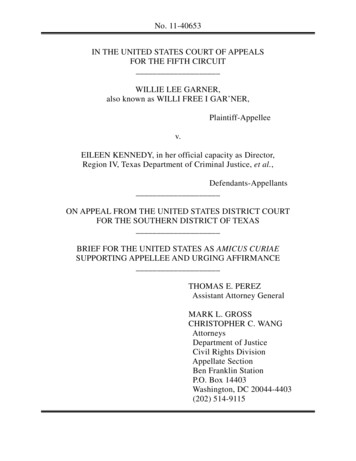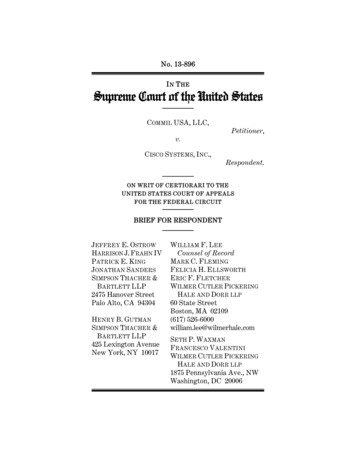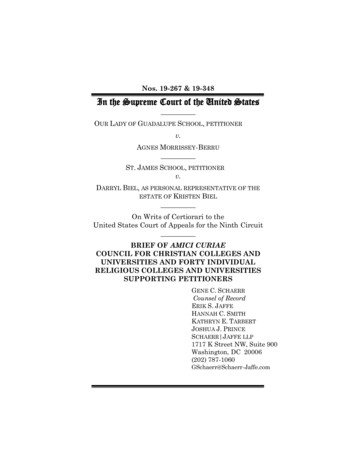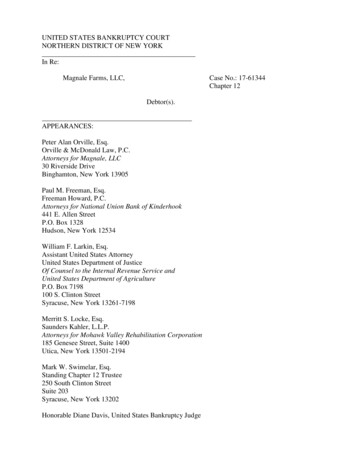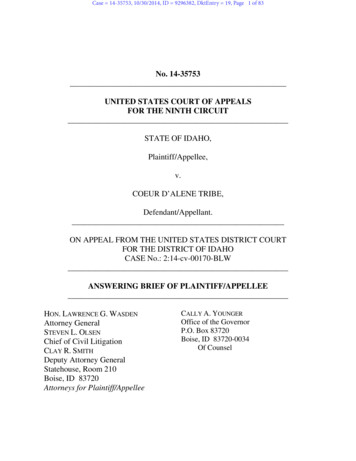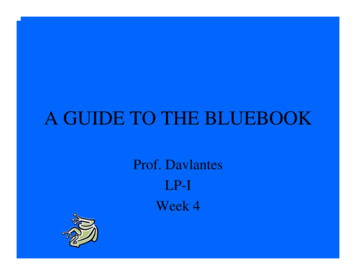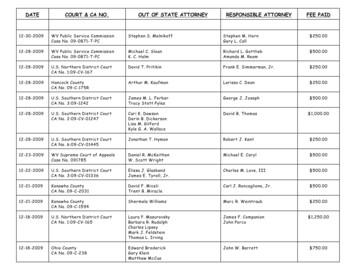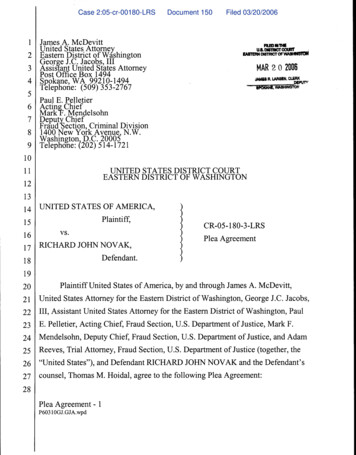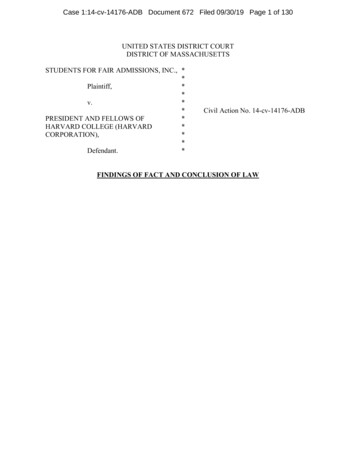
Transcription
Case 1:14-cv-14176-ADB Document 672 Filed 09/30/19 Page 1 of 130UNITED STATES DISTRICT COURTDISTRICT OF MASSACHUSETTSSTUDENTS FOR FAIR ADMISSIONS, INC., **Plaintiff,**v.**PRESIDENT AND FELLOWS OF*HARVARD COLLEGE (HARVARD*CORPORATION),**Defendant.*Civil Action No. 14-cv-14176-ADBFINDINGS OF FACT AND CONCLUSION OF LAW
Case 1:14-cv-14176-ADB Document 672 Filed 09/30/19 Page 2 of 130Table of ContentsI. INTRODUCTION . 4II. PROCEDURAL HISTORY . 4III. FINDINGS OF FACT: DIVERSITY, ADMISSIONS PROCESS, AND LITIGATION . 6A. Diversity at Harvard. 61. Harvard’s Interest in Diversity . 62. Admissions Office’s Efforts to Obtain a Diverse Applicant Pool . 8B. The Admissions Process . 111. The Application . 122. Alumni and Staff Interviews. 133. Application Review Process . 16i. Admissions Office and Personnel . 16ii. Reading Procedures . 18iii. Committee Meetings and Admissions Decisions . 234. Harvard’s Use of Race in Admissions . 27C. Prelude to this Lawsuit. 311. The Unz Article . 312. Analysis by Office of Institutional Research. 32i. Mark Hansen’s Admissions Models. 32ii. Low-Income Admissions Models . 353. The Ryan Committee . 384. The Khurana Committee . 395. The Smith Committee . 40IV. FINDINGS OF FACT: NON-STATISTICAL EVIDENCE OF DISCRIMINATION. 41A. Sparse Country . 41B. The OCR Report . 43C. More Recent Allegations of Stereotyping and Bias . 45V. FINDINGS OF FACT: STATISTICAL ANALYSIS. 50A. Sources of Statistical Evidence . 50B. Admission Rates and Ratings by Race . 53C. Descriptive Statistics . 571. Professor Card’s Multidimensionality Analysis . 572. Professor Arcidiacono’s Academic Index Decile Analysis . 602
Case 1:14-cv-14176-ADB Document 672 Filed 09/30/19 Page 3 of 130D. Overview of Logistic Regression Models. 62E. Regression Models of School Support, Profile, and Overall Ratings . 671. Relationship Between Race and School Support Ratings . 672. Relationship Between Race and Personal Ratings . 683. Regression Models of the Academic, Extracurricular, and Overall Ratings . 73F. Regression Models of Admissions Outcome . 74G. Absence of Statistical Support for Racial Balancing or Quotas . 80VI. FINDINGS OF FACT: RACE-NEUTRAL ALTERNATIVES . 83A. Eliminating Early Action . 85B. ALDC Tips. 86C. Augmenting Recruiting Efforts and Financial Aid . 87D. Increasing Diversity by Admitting More Transfer Students. 88E. Eliminating Standardized Testing . 88F. Place-Based Quotas . 89G. SFFA’s Proposed Combinations of Various Race-Neutral Alternatives . 90VII. CONCLUSIONS OF LAW . 92A. Overview . 92B. SFFA Has Standing. 93C. The Supreme Court and Race-Conscious Admissions . 94D. Harvard’s Admission Program and Strict Scrutiny . 1021. Compelling Interest . 1062. Narrowly Tailored . 107E. Count II: Harvard Does Not Engage in Racial Balancing . 112F. Count III: Harvard Uses Race as a Non-Mechanical Plus Factor . 116G. Count V: No Adequate, Workable, and Sufficient Fully Race-Neutral AlternativesAre Available . 119H. Count I: Harvard Does Not Intentionally Discriminate . 122VIII. CONCLUSION . 1273
Case 1:14-cv-14176-ADB Document 672 Filed 09/30/19 Page 4 of 130BURROUGHS, D.J.I.INTRODUCTIONPlaintiff Students for Fair Admissions, Inc. (“SFFA”) alleges that Defendant Presidentand Fellows of Harvard College (“Harvard”) discriminates against Asian American applicants inthe undergraduate admissions process to Harvard College in violation of Title VI of the CivilRights Act of 1964, 42 U.S.C. §§ 2000d et seq. (“Title VI”). 1 Harvard acknowledges that itsundergraduate admissions process considers race as one factor among many, but claims that itsuse of race is consistent with applicable law.II.PROCEDURAL HISTORYOn November 17, 2014, SFFA initiated this lawsuit by filing a complaint that alleged thatHarvard violates Title VI by intentionally discriminating against Asian Americans (“Count I”),using racial balancing (“Count II”), failing to use race merely as a “plus” factor in admissionsdecisions (“Court III”), failing to use race merely to fill the last “few places” in the incomingfreshman class (“Count IV”), using race where there are available and workable race-neutralalternatives (“Count V”), and using race as a factor in admissions (“Count VI”). [ECF No. 1¶¶ 428–505]. SFFA seeks declaratory judgment, injunctive relief, attorneys’ fees, and costs. Id.at 119. On February 18, 2015, Harvard filed its answer, in which it denied any liability. See[ECF No. 17]. On April 29, 2015, several prospective and then-current Harvard students filed amotion to intervene. [ECF No. 30]. Although the Court denied the motion to intervene, it1There is considerable variation in the terminology individuals use to describe their racial andethnic identities. This opinion uses the terms Hispanic, African American, Asian American, andwhite to describe the four racial or ethnic identities that account for the majority of applicants toHarvard because those are the terms the parties have used in litigating this case. The term AsianAmerican, as opposed to Asian, is used because SFFA alleges that Harvard discriminates againstUnited States citizens who identify as Asian American. Where “Asian” alone is used, thisgenerally reflects the language used by others in their own analyses which are referred to hereinand may include Asian applicants who would not identify as Asian American.4
Case 1:14-cv-14176-ADB Document 672 Filed 09/30/19 Page 5 of 130allowed the students to participate in the action as amici curiae (friends of the court). Studentsfor Fair Admissions, Inc. v. President & Fellows of Harvard Coll., 308 F.R.D. 39, 51–53 (D.Mass.), ECF No. 52, aff’d, 807 F.3d 472 (1st Cir. 2015).On September 23, 2016, Harvard moved (1) to dismiss the lawsuit for lack of standingand (2) for judgment on the pleadings as to Counts IV and VI. [ECF Nos. 185, 187]. On June 2,2017, the Court found that SFFA had the associational standing required to pursue this litigation,because it was an organization whose membership included Asian Americans who had applied toHarvard, been denied admission, and were prepared to apply to transfer to Harvard. Students forFair Admissions, Inc. v. President & Fellows of Harvard Coll. (Harvard Corp.), 261 F. Supp. 3d99, 111 (D. Mass. 2017), ECF No. 324. On the same date, the Court granted Harvard’s motionfor judgment on the pleadings and dismissed Counts IV and VI, namely the failure to use raceonly to fill the last few places in the incoming freshman class and the use of race as a factor inadmissions. Students for Fair Admissions, Inc. v. President & Fellows of Harvard Coll.(Harvard Corp.), No. 14-CV-14176-ADB, 2017 WL 2407254, at *1 (D. Mass. June 2, 2017),ECF No. 325. 2Following the conclusion of discovery, on June 15, 2018, the parties filed cross motionsfor summary judgment on the four remaining counts, [ECF Nos. 412, 417], which the Courtdenied on September 28, 2018. Students for Fair Admissions, Inc. v. President & Fellows ofHarvard Coll., 346 F. Supp. 3d 174, 180 (D. Mass. 2018), ECF No. 566. The case proceeded totrial on Counts I (intentional discrimination), II (racial balancing), III (failure to use race merely2Although discovery ended on May 1, 2018, [ECF Nos. 363, 364], the Court orderedsupplemental document productions during trial when it became apparent that Harvard hadmodified its admissions procedures to provide admissions officers with more explicit guidanceon the use of race despite seemingly contradictory testimony by various witnesses. See [ECFNo. 645 at 7:20–19:24].5
Case 1:14-cv-14176-ADB Document 672 Filed 09/30/19 Page 6 of 130as a “plus” factor), and V (race-neutral alternatives), and from October 15 through November 2,2018, the Court heard testimony from eighteen current and former Harvard employees, fourexpert witnesses, and eight current or former Harvard College students who testified as amicicuriae. On February 13, 2019, following the parties’ submissions of proposed findings of factand conclusions of law and responses to each other’s respective submissions, see [ECF Nos. 619,620], the Court heard final closing arguments.The Court now makes the following findings of fact and conclusions of law inaccordance with Federal Rule of Civil Procedure 52(a).III.FINDINGS OF FACT: DIVERSITY, ADMISSIONS PROCESS, ANDLITIGATIONA.Diversity at Harvard1.Harvard’s Interest in DiversityIt is somewhat axiomatic at this point that diversity of all sorts, including racial diversity,is an important aspect of education. See Brown v. Bd. of Educ., 347 U.S. 483 (1954). 3 The3On October 30, 2018, the Court heard testimony from Dr. Ruth Simmons, the current Presidentof Prairie View A&M University. President Simmons was born in a sharecropper’s shack on aplantation in Grapeland, Texas. She attended primary and secondary school in a completelysegregated environment in Houston, and then Dillard University, an African American institutionsupported by the Methodist Church in New Orleans. President Simmons was selected to spendher junior year of college at Wellesley, where she studied alongside white students in the UnitedStates for the first time. After graduating from Dillard University, President Simmons traveledto France, where she studied as a Fulbright Scholar. She then returned to the United States andearned a Ph.D. from Harvard’s Department of Romance Languages and Literatures. PresidentSimmons held positions at Princeton University, Spelman College, and Smith College beforebecoming President of Brown University. She retired from Brown University after eleven yearsand returned to Texas, where she worked on nonprofit projects in the Houston area before beingpersuaded to come out of retirement to serve as the president of Prairie View A&M. PresidentSimmons offered expert testimony on Harvard’s interest in diversity. Her testimony and her lifestory, perhaps the most cogent and compelling testimony presented at this trial, demonstrate theextraordinary benefits that diversity in education can achieve, for students and institutions alike.See [Oct. 30 Tr. 6:11–70:23].6
Case 1:14-cv-14176-ADB Document 672 Filed 09/30/19 Page 7 of 130evidence at trial was clear that a heterogeneous student body promotes a more robust academicenvironment with a greater depth and breadth of learning, encourages learning outside theclassroom, and creates a richer sense of community. See [Oct. 19 Tr. 185:23–187:24; Oct. 23 Tr.24:13-20, 31:2–34:11, 59:8–14; Oct. 30 Tr. 27:20–28:8]. The benefits of a diverse student bodyare also likely to be reflected by the accomplishments of graduates and improved facultyscholarship following exposure to varying perspectives. See [Oct. 30 Tr. 28:9–30:11].Harvard College’s mission, as articulated in its mission statement, is “to educate thecitizens and citizen-leaders for our society” and it seeks to accomplish this “through . . . thetransformative power of a liberal arts and sciences education.” [DX109 at 1]. 4 In aid ofrealizing its mission, Harvard values and pursues many kinds of diversity within its classes,including different academic interests, belief systems, political views, geographic origins, familycircumstances, and racial identities. See [Oct. 17 Tr. 182:17–183:7; Oct. 23 Tr. 24:13–20]. Thisinterest in diversity and the wide-ranging benefits of diversity were echoed by all of the Harvardadmissions officers, faculty, students, and alumni that testified at trial. SFFA does not contestthe importance of diversity in education, but argues that Harvard’s emphasis on racial diversity istoo narrow and that the full benefits of diversity can be better achieved by placing moreemphasis on economic diversity. See [ECF No. 620 ¶¶ 216, 231].Consistent with Harvard’s view of the benefits of diversity in and out of the classroom,Harvard tries to create opportunities for interactions between students from differentbackgrounds and with different experiences to stimulate both academic and non-academiclearning. [Oct. 23 Tr. 39:3–17; Oct. 30 Tr. 25:11–26:6, 27:20–28:8]. As examples, studentliving assignments, the available extracurricular opportunities, and Harvard’s athletic programs4“DX” refers to an exhibit offered by Harvard.7
Case 1:14-cv-14176-ADB Document 672 Filed 09/30/19 Page 8 of 130are all intended to promote a sense of community and encourage exposure to diverse individualsand viewpoints. [Oct. 23 Tr. 39:18–41:23].Harvard has evaluated and affirmed its interest in diversity on multiple occasions. See[Oct. 17 Tr. 182:4–14]; see, e.g., [PX302; DX26; DX53]. 5 Most recently, in 2015, Harvardestablished the Committee to Study the Importance of Student Body Diversity, which waschaired by Dean Rakesh Khurana 6 (the “Khurana Committee”). [Oct. 23 Tr. 34:12–22]. TheKhurana Committee reached the credible and well-reasoned conclusion that the benefits ofdiversity at Harvard are “real and profound.” [PX302 at 17]. It endorsed Harvard’s efforts toenroll a diverse student body to “enhance[] the education of [its] students of all races andbackgrounds [to] prepare[] them to assume leadership roles in the increasingly pluralistic societyinto which they will graduate,” achieve the “benefits that flow from [its] students’ exposure topeople of different backgrounds, races, and life experiences” by teaching students to engageacross differences through immersion in a diverse community, and broaden the perspectives ofteachers, to expand the reach of the curriculum and the range of scholarly interests. [PX302 at1–2, 6]; see also [Oct. 23 Tr. 37:14–38:17]. The Khurana Committee “emphatically embrace[d]and reaffirm[ed] the University’s long-held view that student body diversity – including racialdiversity – is essential to [its] pedagogical objectives and institutional mission.” [PX302 at 22].2.Admissions Office’s Efforts to Obtain a Diverse Applicant PoolHarvard’s Office of Admissions and Financial Aid (the “Admissions Office”) is taskedwith deciding which students to accept to the College and which to reject or waitlist. [Oct. 155“PX” refers to an exhibit offered by SFFA.6Dean of Harvard College Rakesh Khurana attended SUNY-Binghamton and Cornell Universityfor his undergraduate studies. He received a Ph.D. in organizational behavior from HarvardUniversity. [Oct. 22 Tr. 192:17–193:11].8
Case 1:14-cv-14176-ADB Document 672 Filed 09/30/19 Page 9 of 130Tr. 64:1–70:8]. Deciding which applicants to admit is challenging given the overall talent andsize of the applicant pool. For example, there were approximately 35,000 applications foradmission to the class of 2019. [Oct. 17 Tr. 184:2–4]. Harvard, targeting a class size of roughly1,600 students, admitted only about 2,000 of those applicants, based on its expectation thatapproximately 80% of admitted students would matriculate. [Id. at 184:22–185:11]. 7 Amongthe applicants for that class, approximately 2,700 had a perfect verbal SAT score, 3,400 had aperfect math SAT score, and more than 8,000 had perfect GPAs. [Id. at 184:14–21]. Clearly,given the size and strength of its applicant pool, Harvard cannot admit every applicant withexceptional academic credentials. To admit every applicant with a perfect GPA, Harvard wouldneed to expand its class size by approximately 400% and then reject every applicant with animperfect GPA without regard to their athletic, extracurricular, and other academicachievements, or their life experiences. Because academic excellence is necessary but not alonesufficient for admission to Harvard College, the Admissions Office seeks to attract applicantswho are exceptional across multiple dimensions or who demonstrate a truly unusual potential forscholarship through more than just standardized test scores or high school grades. [Id. at181:12–183:7].To help attract exceptionally strong and diverse annual applicant pools, Harvard engagesin extensive and multifaceted outreach efforts. Each year, roughly 100,000 students make it ontoHarvard’s “search list” through data, including test scores, that the college purchases from ACT 8which administers the ACT, and the College Board, which administers the PSAT and the SAT.7Harvard admitted 5.8% of applicants to its class of 2017 and 5.7% to its class of 2018. [Oct. 15Tr. 157:21–25].8The American College Testing Company changed its name to ACT in the 1990s.9
Case 1:14-cv-14176-ADB Document 672 Filed 09/30/19 Page 10 of 130[Oct. 15 Tr. 130:2–131:1; Oct. 17 Tr. 146:2–16]. High school students who make the search listreceive a letter that encourages them to consider Harvard and may also receive follow-upcommunications. See [Oct. 15 Tr. 131:5–134:16; Oct. 17 Tr. 146:3–12; PX55]. Harvard alsouses the search list to target students as part of its extensive in-person recruiting efforts, whichincludes Harvard admissions officers travelling to over 100 locations across the United States tospeak with potential applicants and encourage them to consider Harvard. [Oct. 15 Tr. 131:13–20; Oct. 17 Tr. 146:7–12, 179:8–21]. The search list is also sent to Harvard’s “schoolscommittee,” which is comprised of more than 10,000 alumni who help recruit and interviewapplicants and help persuade admitted students to attend Harvard. [Oct. 15 Tr. 131:21–132:7].In addition to recruiting students based largely on test scores, Harvard places particularemphasis on communicating with potential low-income and minority applicants whose academicpotential might not be fully reflected in their scores. Since the 1970s, Harvard has recruitedminority students, including Asian Americans, through its Undergraduate Minority RecruitmentProgram (“UMRP”). [Oct. 24 Tr. 95:15–21]. The UMRP writes letters, calls, and sends currentHarvard undergraduates to their hometowns to speak with prospective applicants. [Id. at 95:12–102:3]. The program, led by a full-time director and an assistant director, employs between twoand ten Harvard students for most of the year, with twenty-five to thirty students working for theprogram during its peak season. [Id. at 201:1–204:22].Despite these efforts, African American and Hispanic applicants remain a relativelymodest portion of Harvard’s applicant pool, together accounting for only about 20% of domesticapplicants to Harvard each year, even though those groups make up slightly more than 30% ofthe population of the United States. See [PX623; DX713]; U.S. Census Bureau, QuickFacts,Census.gov, I225218. In contrast, Asian10
Case 1:14-cv-14176-ADB Document 672 Filed 09/30/19 Page 11 of 130American high school students have accounted for approximately 22% of total applicants inrecent years, although Asian Americans make up less than 6% of the national population. See[DX713]; U.S. Census Bureau, QuickFacts, table/US/RHI225218.Harvard’s recruiting efforts also target low-income and first-generation college studentsirrespective of racial identity through a recruiting program that operates in conjunction with theHarvard Financial Aid Initiative (“HFAI”). Harvard’s financial aid program guarantees fullfunding of a Harvard education for students from families earning 65,000 or less per year andalso caps contributions at 10% of income for families making up to 150,000 per year. [Oct. 24Tr. 102:10–104:19; PX316 at 6]. Harvard, through the HFAI recruitment program, employsstudents who return to their hometowns and visit high schools to talk about the affordability ofHarvard and other colleges with need-blind admissions programs. [Oct. 24 Tr. 144:1–22].Today, more than half of Harvard students receive need-based aid. [Id. at 150:3–6].B.The Admissions ProcessSeveral Harvard admissions officers testified generally about reviewing application filesas well as about their review of specific files. The Court credits this testimony. They eachdescribed a time-consuming, whole-person review process where every applicant is evaluated asa unique individual. See, e.g., [Oct. 17 Tr. 205:6–223:10; Oct. 24 Tr. 174:19–175:23]; see also[DD1]. 9 Admissions officers attempt to make collective judgments about each applicant’spersonality, intellectual curiosity, character, intelligence, perspective, and skillset and to evaluateeach applicant’s accomplishments in the context of his or her personal and socioeconomiccircumstances, all with the aim of making admissions decisions based on a more complete9“DD” refers to demonstrative evidence presented by Harvard.11
Case 1:14-cv-14176-ADB Document 672 Filed 09/30/19 Page 12 of 130understanding of an applicant’s potential than can be achieved by relying solely on objectivecriteria. [Oct. 16 Tr. 16:15–22; Oct. 17 Tr. 182:17–183:7, 209:16–223:10]; see, e.g., [Oct. 18 Tr.22:9–48:4; DX293].1.The ApplicationStudents apply to Harvard either through the early action program or the regular decisionprogram. 10 All applications are reviewed in the same way regardless of whether a student hasapplied for early action or regular decision. [Oct. 18 Tr. 15:5–10]; see [PX1]. The AdmissionsOffice may accept, reject, or waitlist applicants, or, in the case of early action applicants, deferthem into the regular decision applicant pool. [Oct. 18 Tr. 124:14–125:9]. Students who applyfor early action are admitted at a higher rate than regular decision applicants. [Oct. 25 Tr.242:19–243:17].Students apply to Harvard by submitting the Common Application or the UniversalCollege Application. [Oct. 17 Tr. 186:1–10; Nov. 1 Tr. 27:13–19]. A complete applicationgenerally includes standardized test scores, high school transcript(s), information aboutextracurricular and athletic activities, intended concentration and career, a personal statement,supplemental essays, teacher and guidance counselor recommendations, and other informationabout the applicant, including high school and personal and family background, such as place ofbirth, citizenship, disciplinary or criminal history, race, siblings’ names and educations, and10Harvard eliminated its early action program for the classes of 2012 through 2015, in part toimprove the socioeconomic diversity of its students. [PX316 at 15]; see [DX728]. Eliminatingearly action, however, did not have the expected effect on class diversity, and Harvard’s peerinstitutions largely continued with their early action and early decision programs. [PX316 at 15].Harvard became concerned that it was losing some of the most competitive applicants to othercolleges that offered early decision or early action and decided to reverse course and reinstate itsearly action program for the class of 2016. [Oct. 17 Tr. 163:9–164:1; Oct. 18 Tr. 89:13–91:19;Oct. 22 Tr. 100:6–101:15, 185:2–186:8; Oct. 23 Tr. 158:14–160:19; DX39 at 4].12
Case 1:14-cv-14176-ADB Document 672 Filed 09/30/19 Page 13 of 130parents’ education, occupation, and marital status. See, e.g., [DX195, DX262, DX276, DX293,DX527, SA1, SA2, SA3, SA4]. 11 Applicants can also supplement their applications withsamples of their academic or artistic work, which may be reviewed and evaluated by Harvardfaculty. [Oct. 17 Tr. 189:5–14; Oct. 18 Tr. 31:21–32:13]; see, e.g., [DX276 at 41; DX293 at 42].Applicants may, but are not required to, identify their race in their application by discussing theirracial or ethnic identity in their personal statement or essays or by checking the box on theapplication form for one or more preset racial groups (e.g. American Indian or Alaskan Native,Asian, Black or African American, Native Hawaiian or Other Pacific Islander, or White) andmay also select or indicate a subcategory of these groups. See [Oct. 18 Tr. 52:8–14; Oct. 26 Tr.98:2–6; SA2 at 4; SA3 at 8]. 12 If applicants disclose their racial identities, Harvard may takerace into account, regardless of whether applicants write about that aspect of their backgroundsor otherwise indicate that it is an important component of who they are. [Oct. 26 Tr. 91:17–92:1].2.Alumni and Staff InterviewsMost applicants interview with a Harvard alumnus. [Oct. 15 Tr. 128:2–6]. Harvardselects alumni to interview candidates based predominantly on geographic considerations.Alumni interviewers are provided with an Interviewer Handbook that describes the admissionsprocess. [Id. at 127:9–128:1]; see [DX5]. Although interviewers have broad discretion indeciding where to conduct the interview, what information to request in advance, and what to11“SA” refers to evidence offered by student amici.12Harvard could elect not to receive information about applicants’ race for all applicants or someracial subgroups. In fact, Harvard no longer receives information about applicants’ religiousaffiliation, [Oct. 19 Tr. 186:7–187:18], although it does continue to receive some informationabout applicants’ religions and beliefs from applicants who choose to write about their religiousidentities in their essays or their personal statements, [id. at 246:25–247:17].13
Case 1:14-cv-14176-ADB Document 672 Filed 09/30/19 Page 14 of 130ask, Harvard specifies several questions that alumni interviewers should not ask and alsoinstructs alumni not to advise applicants on their chances of admission, given that “this analysiscan only be accomplished with full access to all the material in an applicant’s file and throughthe extensive discussions shared and comparisons made through the Committee process.” [DX5at 30–34]. Alumni interviews generally last from 45 minutes to an hour. [Oct. 17 Tr. 218:25–219:9].Alumni interviewers do not have all of the information that is available to admissionsofficers at the time of admissions decisions, but their evaluations can be uniquely helpful toadmissions officers, as alumni interviews are often an applicant’s sole in-person interaction witha Harvard repres
Oct 30, 2019 · and Fellows of Harvard College (“Harvard”) discriminates against Asian American applicants in the undergraduate admissions process to Harvard College in violation of Title VI of the Civil Rights



